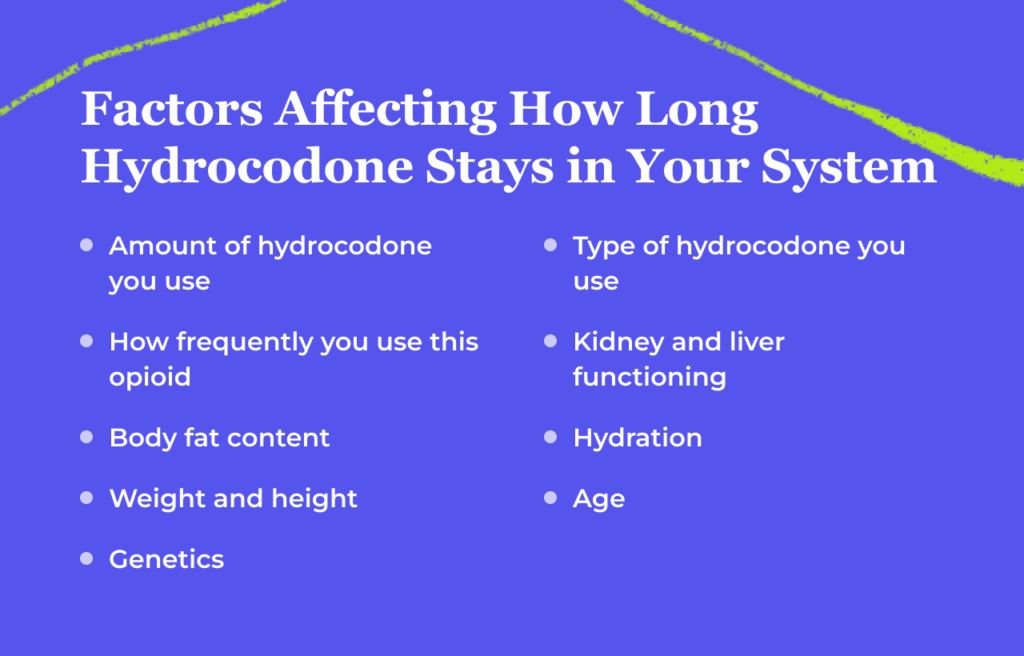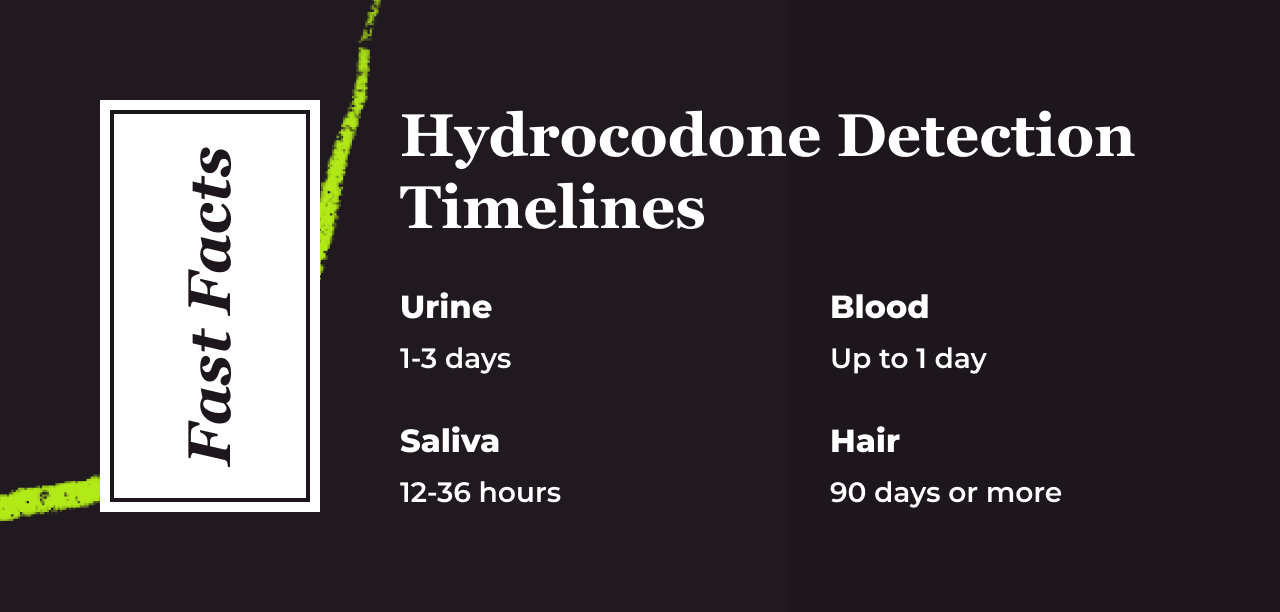Hydrocodone is an opioid painkiller prescribed to treat moderate to severe pain, although many people misuse it for its euphoric effects. Short-acting hydrocodone stays in your system for a little over one day while long-acting or extended-release hydrocodone stays in your system for between two and three days.
However, depending on the type of drug test, hydrocodone can be detected for longer than it stays in your system. Here are the hydrocodone detection timelines:[1],[2]
- Urine: 1-3 days
- Blood: Up to 1 day
- Saliva: 12-36 hours
- Hair: 90 days or more
If you are searching for how long hydrocodone stays in your system, it’s possible you may be struggling with hydrocodone misuse or opioid use disorder. At Bicycle Health, we offer online Suboxone therapy to help you quit using opioids and obtain lifelong recovery.
Short-acting hydrocodone stays in your system for about one day, while extended-release hydrocodone stays in your system for about two or three days.
Hydrocodone Half-Life and Duration of Effects
The half-life of a drug refers to the amount of time it takes the drug to be reduced to 50% in the body. The half-life directly affects how long a drug like hydrocodone stays in your system and its detection window on drug tests.
The half-life of short-acting hydrocodone is between 3.8 and 4.5 hours, which means it stays in your system for a little over one day.[1],[2]
Meanwhile, the half-life of the long-acting or extended-release formulation of hydrocodone is between 7 and 9 hours, meaning it stays in your system for between two and three days.[1],[2]
Hydrocodone’s onset and duration of effects are also related to half-life. The immediate-release formulations have a more rapid onset of effects, especially if someone snorts or injects hydrocodone (as opposed to swallowing pills), and a shorter high. On the other hand, extended-release hydrocodone has a more delayed onset of effects and lasts for longer.
How Long Does Hydrocodone Stay in Your Body?

The amount of time hydrocodone stays in your system depends on many factors, including whether it is the immediate-release or extended-release formulation. Short-acting hydrocodone stays in your system for about 24 hours, while long-acting hydrocodone stays in your system for between 48 and 72 hours.[1],[2]
However, these are just estimates. The length of time hydrocodone stays in your system depends on many influences, such as:
- Amount of hydrocodone you use
- Type of hydrocodone you use
- How frequently you use this opioid
- Kidney and liver functioning
- Body fat content
- Hydration
- Weight and height
- Genetics
- Age
- Metabolism
Hydrocodone Detection Timeline

In general, hydrocodone can be detected for the following lengths of time since last use, depending on the test type:[1],[2]
| Type of Drug Test | Detection Window |
| Urine | 1-3 days |
| Blood | Up to 24 hours |
| Saliva | 12-36 hours |
| Hair | Up to 90 days |
These time frames are just general guidelines. Exact time frames will vary depending on individual circumstances. It’s always best to consult with a medical professional or drug testing expert for more specific information.
Hair testing specifically comes with several caveats. First, hair testing is generally avoided when possible, as it is relatively invasive, requiring a portion of a person’s hair be cut for testing. Second, the actual detection window can change significantly depending on when a person last cut their hair, especially if they intentionally have it cut to reduce the chance of their drug use being detected.
Factors That Affect How Long Hydrocodone Can Be Detected
The detectability window of hydrocodone use can vary depending on various factors, such as the frequency and duration of use, personal metabolism of an individual, and the type of drug test used.
The chemical properties and structures of different drugs greatly affect their detectability. For example, drugs with higher lipid solubility (such as marijuana) have longer detection windows, while those with less lipid-solubility (like cocaine or heroin) have shorter detection windows. In addition, drugs that are highly water-soluble like alcohol are quickly eliminated from the body.
Individuals who use substances frequently for longer periods will most likely have higher detectable levels in their system compared to one-time users whose use may not be noticeable after a shorter time frame due to minimal metabolite buildup from infrequent use.[3] This is especially true for very small, incidental exposure, such as accidentally drinking water that might be somewhat contaminated with hydrocodone.
When attempting to determine whether someone has ingested illicit substances, physiological traits must be considered alongside other factors, such as drug potency and consumption quantity. Differences between people in how quickly they break down compounds mean that some individuals will retain evidence of drug use for different lengths of time depending on their metabolic speed. Some people have health conditions that can slow metabolism, making their hydrocodone detection window longer than expected.
How Does the Body Metabolize & Break Down Hydrocodone?
When hydrocodone is taken orally, it is rapidly absorbed from the gastrointestinal tract and undergoes extensive metabolism in the liver.[4] Metabolization is how the body generally breaks down drugs, slowly altering them to the point where they can then be excreted from the body through waste.
The primary enzyme responsible for metabolizing hydrocodone is CYP2D6, which converts the drug into its primary metabolite, hydromorphone.[3]
Hydrocodone is also metabolized into two other minor metabolites, norhydrocodone and dihydrocodeine, which are active opioids but less potent than the parent drug.[5]
The metabolites of hydrocodone are excreted in the urine, with approximately 95% of standard hydrocodone and its metabolites being eliminated within 24 hours after administration.[3]
Again, the elimination half-life of hydrocodone is approximately three to four hours, but this can vary based on individual factors such as age, liver function, and other medications being taken concurrently.
Types of Hydrocodone
Hydrocodone is a potent opioid medication used to relieve moderate to severe pain.[6] Hydrocodone comes in both an immediate-release form and an extended-release form, both of which can serve a legitimate role in relieving pain if prescribed and used properly.
Immediate-Release Hydrocodone
Immediate-release hydrocodone is usually prescribed for acute pain, such as pain after a surgical procedure or injury.
The effects of immediate-release hydrocodone typically occur within 10 to 30 minutes and last for about four to six hours.[7] However, the exact duration of its effects can vary depending on various factors, such as dose, individual tolerance, and metabolism.
Extended-Release Hydrocodone
Extended-release hydrocodone is designed to provide pain relief that lasts longer than the immediate-release formulation. It is usually prescribed for chronic pain conditions that require around-the-clock treatment. The effects of extended-release hydrocodone can last for up to 12 hours, but again, this can vary based on individual factors such as metabolism and tolerance.
Duration of Effects
The method of administration will influence how quickly hydrocodone’s effects take place and how long the drug stays in your system.
Oral Administration
Hydrocodone is usually taken orally via tablets or capsules. When taken in this way, effects will begin within about an hour, usually within 30 minutes.
The effects with oral intake will be the least intense and longest lasting among the various administration methods. Hydrocodone is usually intended to be taken in this way.
Injection
Hydrocodone is sometimes injected. Users crush tablets, dissolve them in water, and then inject the solution. This causes an intense and almost immediate high, but the effects wear off more quickly.
Depending on the type of hydrocodone used, the effects of the drug may last up to two to three hours when taken in this manner.
Injection drug use carries a very high risk for overdose as well as other harm, such as the contraction of blood-borne diseases like HIV and hepatitis.[8]
Inhalation
Some people snort hydrocodone, which can cause a fairly fast and intense high. Tablets are crushed, and the user then snorts the resulting powder.
When snorted, hydrocodone will affect a user within minutes. The effects will last a few hours, although not as long as if the drug was taken orally.
There are various risks associated with snorting hydrocodone in addition to the standard risks associated with any misuse of the drug.[9]

Reviewed By Peter Manza, PhD
Peter Manza, PhD received his BA in Psychology and Biology from the University of Rochester and his PhD in Integrative Neuroscience at Stony Brook University. He is currently working as a research scientist in Washington, DC. His research focuses on the role ... Read More
- Oxycodone and Hydrocodone: Detection in Urine, Oral Fluid, and Blood. Substance Abuse and Mental Health Services Administration. https://www.samhsa.gov/sites/default/files/meeting/documents/flegel-research-studies-dtab-june-2014.pdf. June 2014. Accessed March 2023.
- Drug Plasma Half-Life and Urine Detection Window. ARUP Laboratories. https://www.aruplab.com/files/resources/pain-management/DrugAnalytesPlasmaUrine.pdf. September 2022. Accessed March 2023.
- Opioid Metabolism. Mayo Clinic Proceedings. https://www.ncbi.nlm.nih.gov/pmc/articles/PMC2704133/. July 2009. Accessed March 2023.
- Preclinical and Clinical Pharmacology of Hydrocodone for Chronic Pain: A Mini Review. Frontiers in Pharmacology. https://www.frontiersin.org/articles/10.3389/fphar.2018.01122/full. October 2018. Accessed March 2023.
- Excretion Profile of Hydrocodone, Hydromorphone and Norhydrocodone in Urine Following Single Dose Administration of Hydrocodone to Healthy Volunteers. Journal of Analytical Toxicology. https://academic.oup.com/jat/article/36/7/507/829318. September 2012. Accessed March 2023.
- Hydrocodone. U.S. National Library of Medicine. https://medlineplus.gov/druginfo/meds/a614045.html. January 2021. Accessed March 2023.
- Onset, Peak and Duration of Common Pain Medications. Texas Health and Human Services. https://www.hhs.texas.gov/sites/default/files/documents/doing-business-with-hhs/provider-portal/QMP/PainMedicationTable.pdf. Accessed March 2023.
- Harm Reduction Interventions for People Who Inject Drugs. The Lancet. https://www.thelancet.com/journals/langlo/article/PIIS2214-109X(23)00111-0/fulltext. March 2023. Accessed March 2023.
- Hydrocodone Snorting Leading to Hypersensitivity Pneumonitis. Baylor University Medical Center Proceedings. https://www.ncbi.nlm.nih.gov/pmc/articles/PMC4900771/. July 2016. Accessed March 2023.
Download Our Free Program Guide
Learn about our program, its effectiveness and what to expect
Related Content
Imagine what’s possible on the other side of opioid use disorder.
Our science-backed approach boasts 95% of patients reporting no withdrawal symptoms at 7 days. We can help you achieve easier days and a happier future.